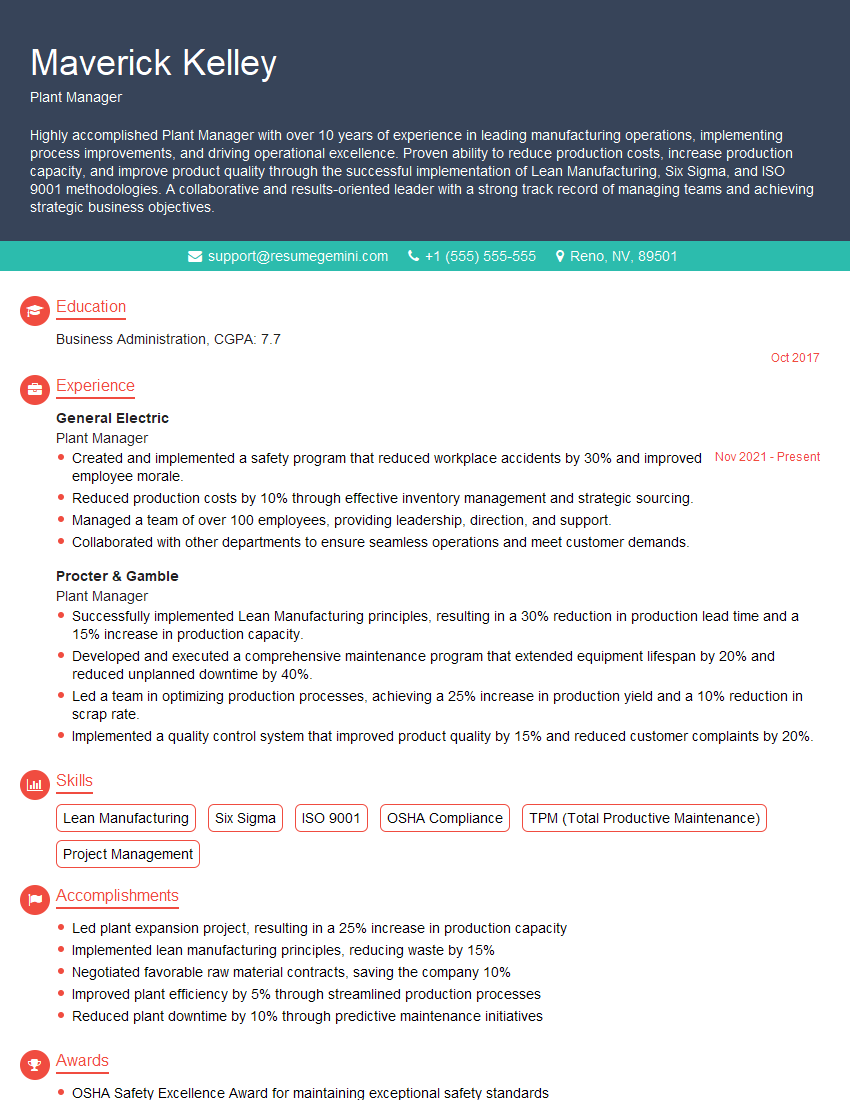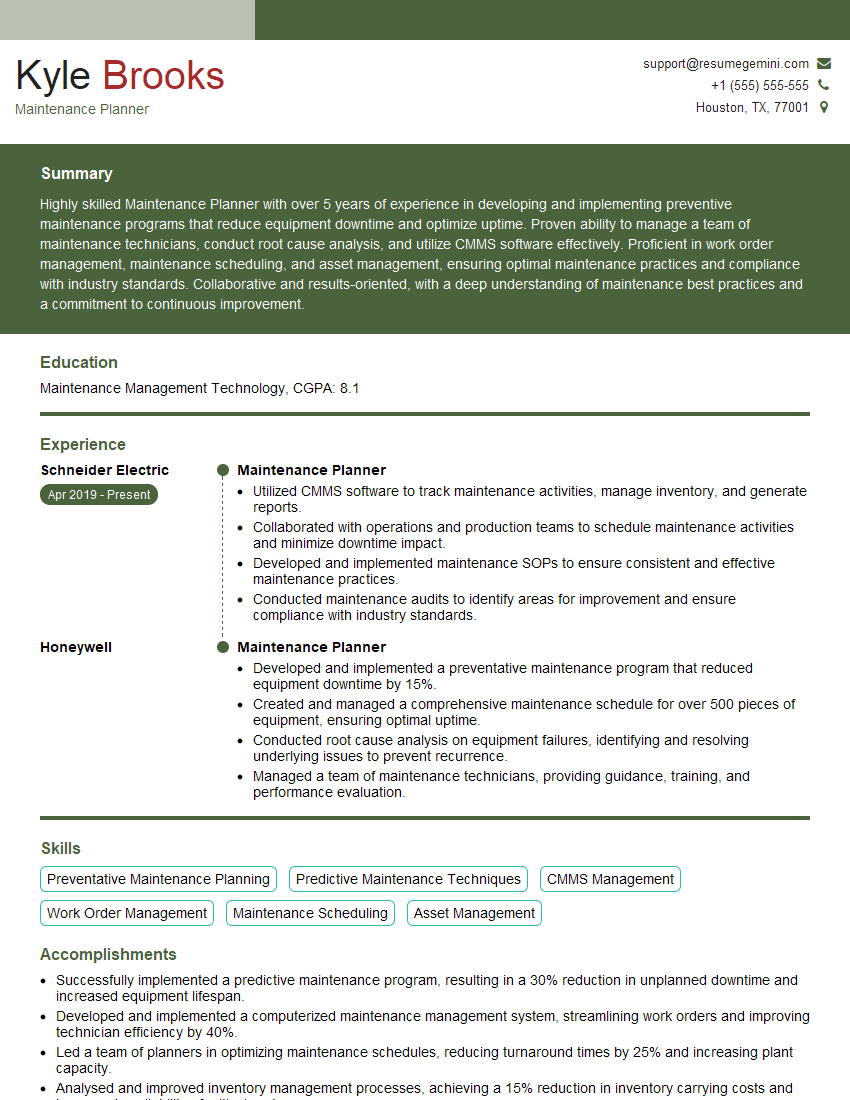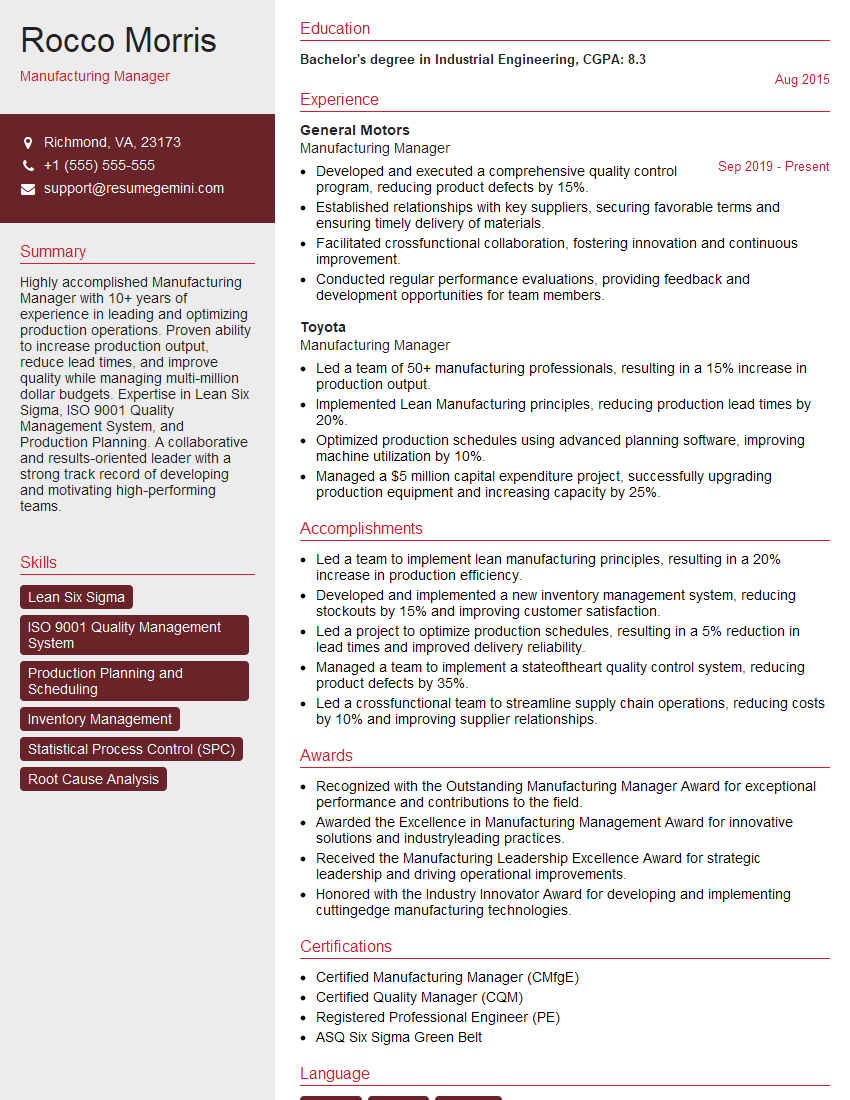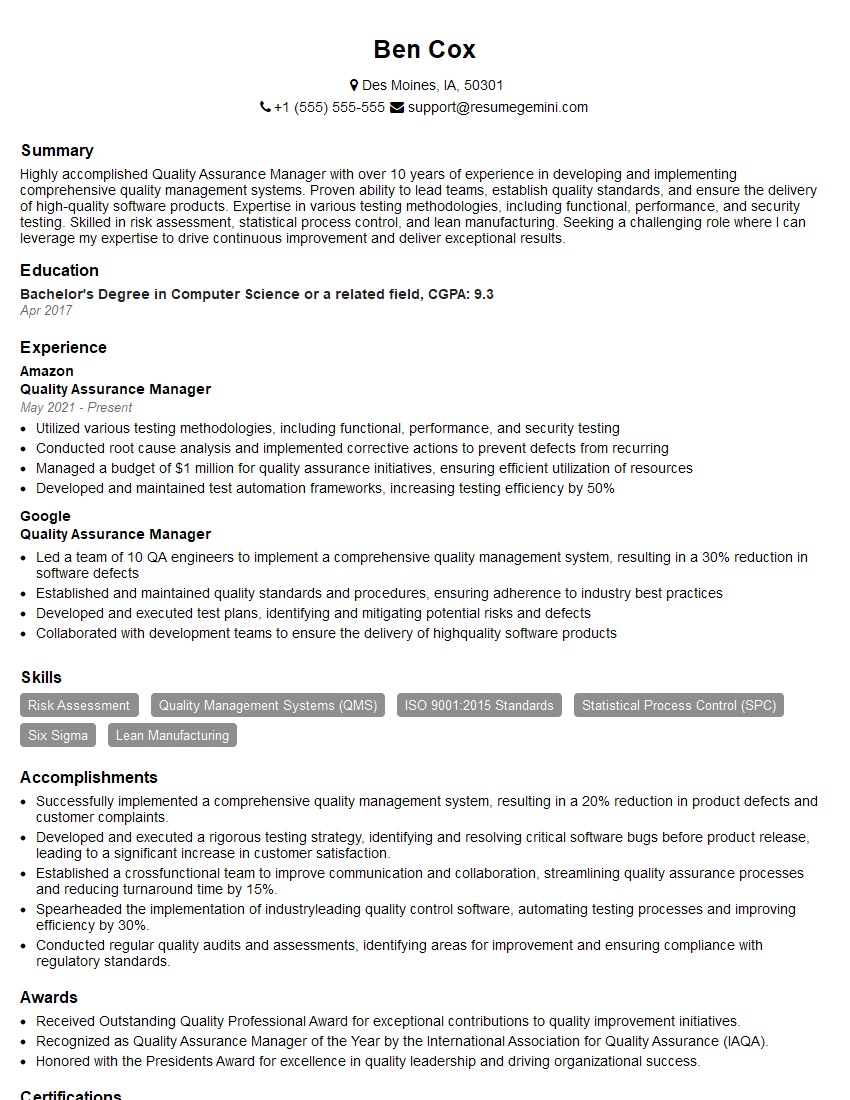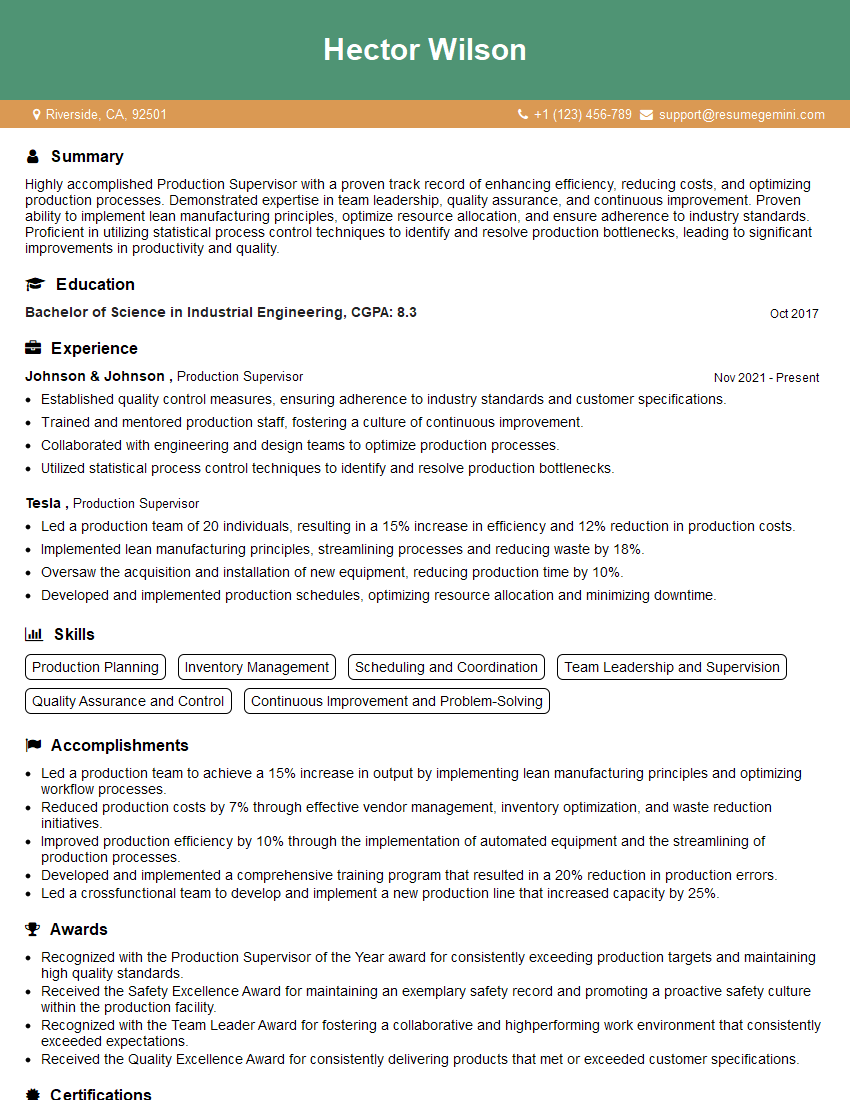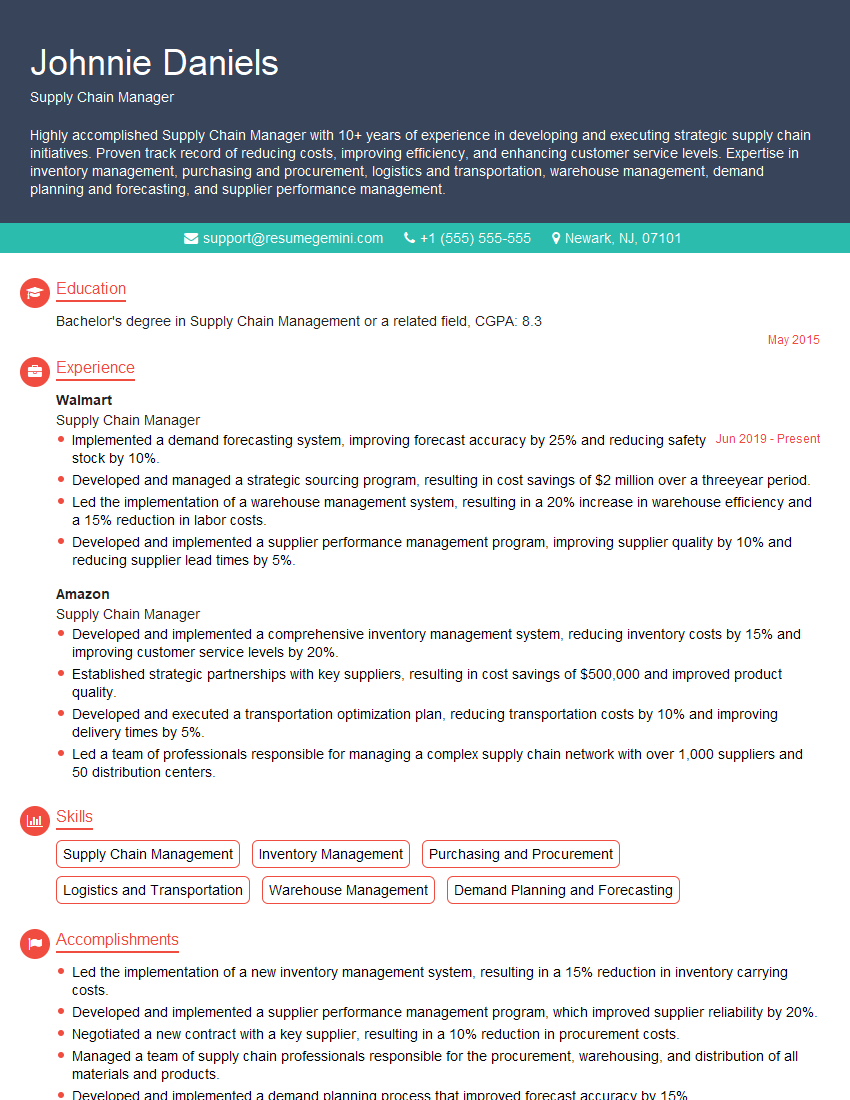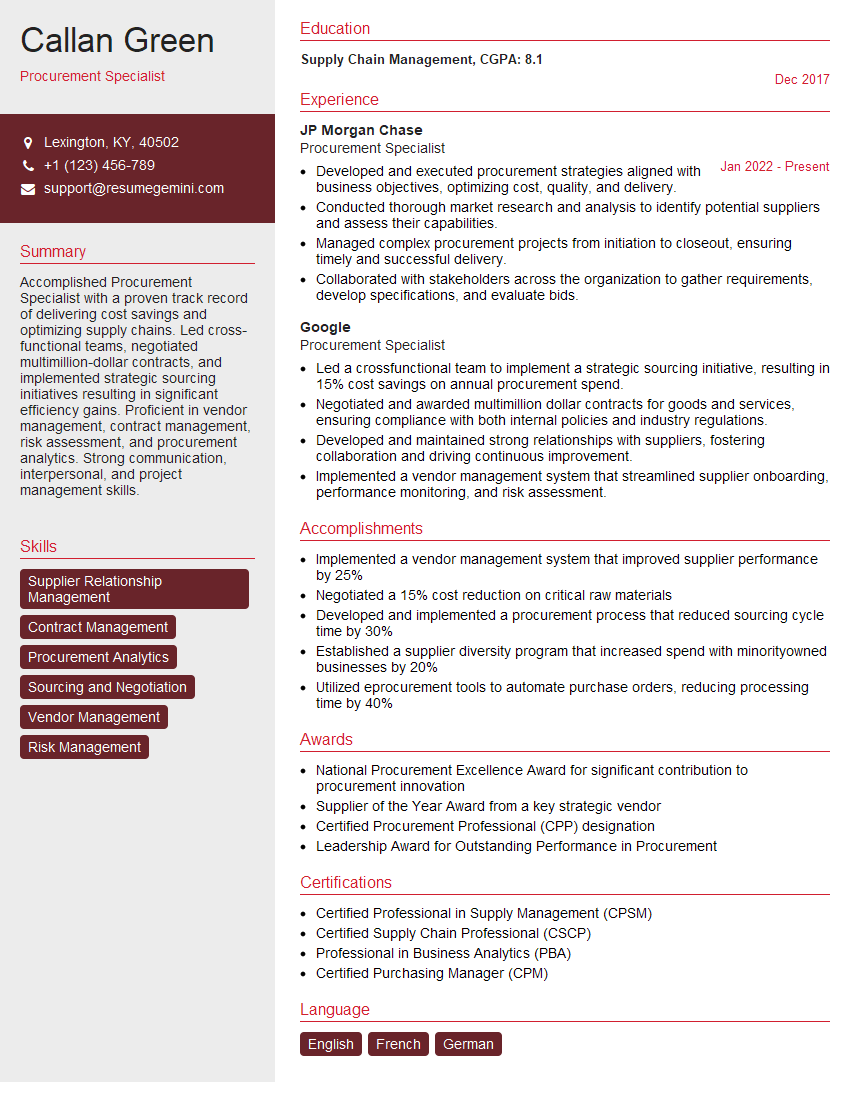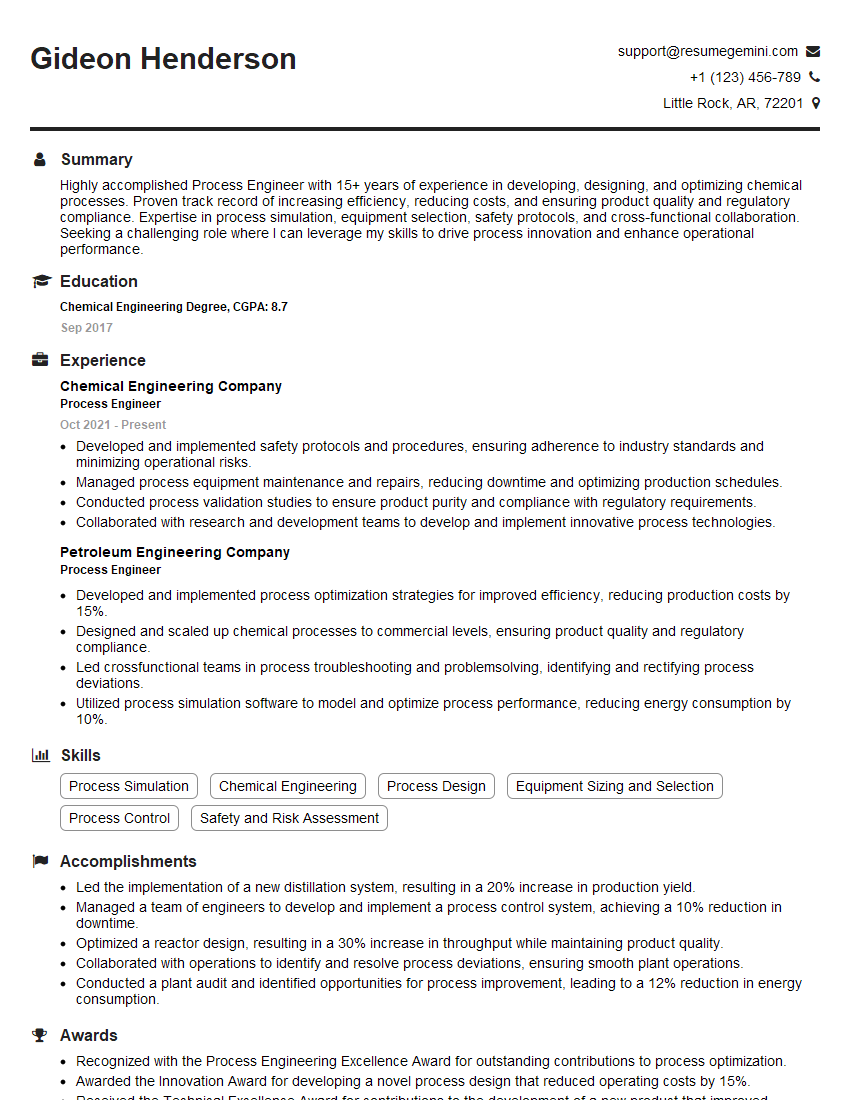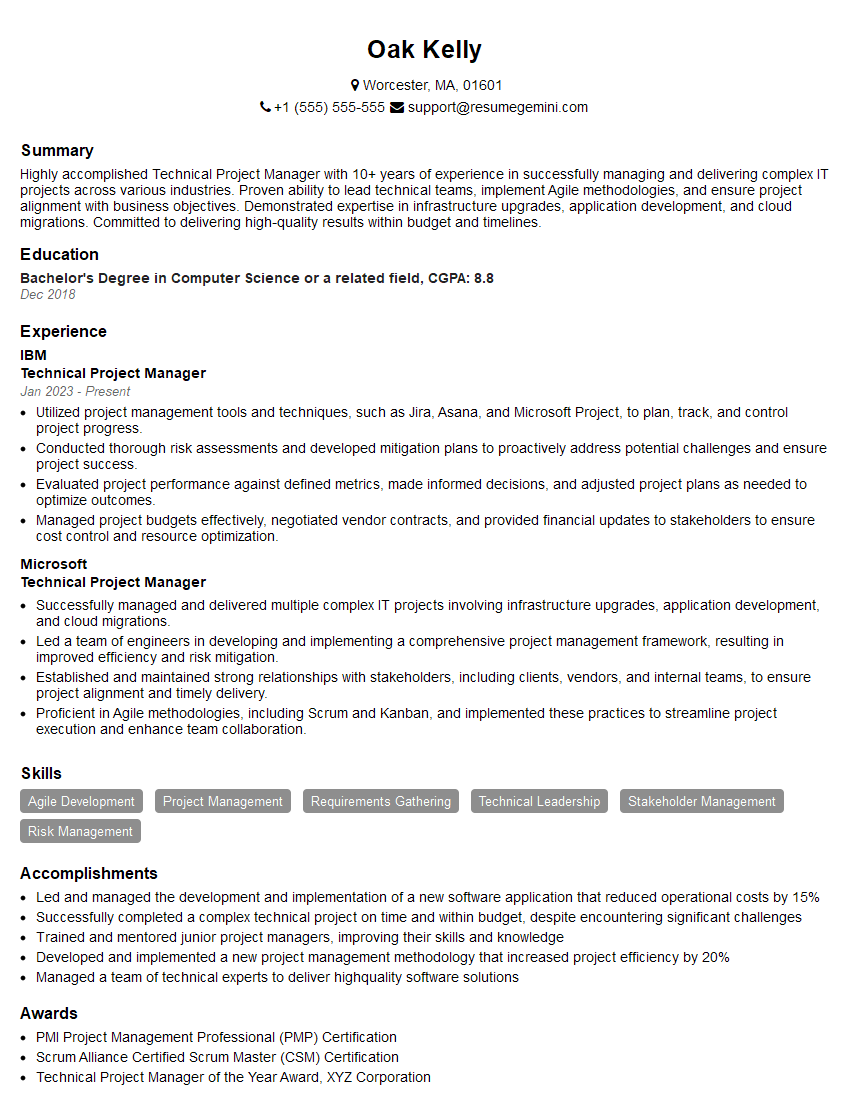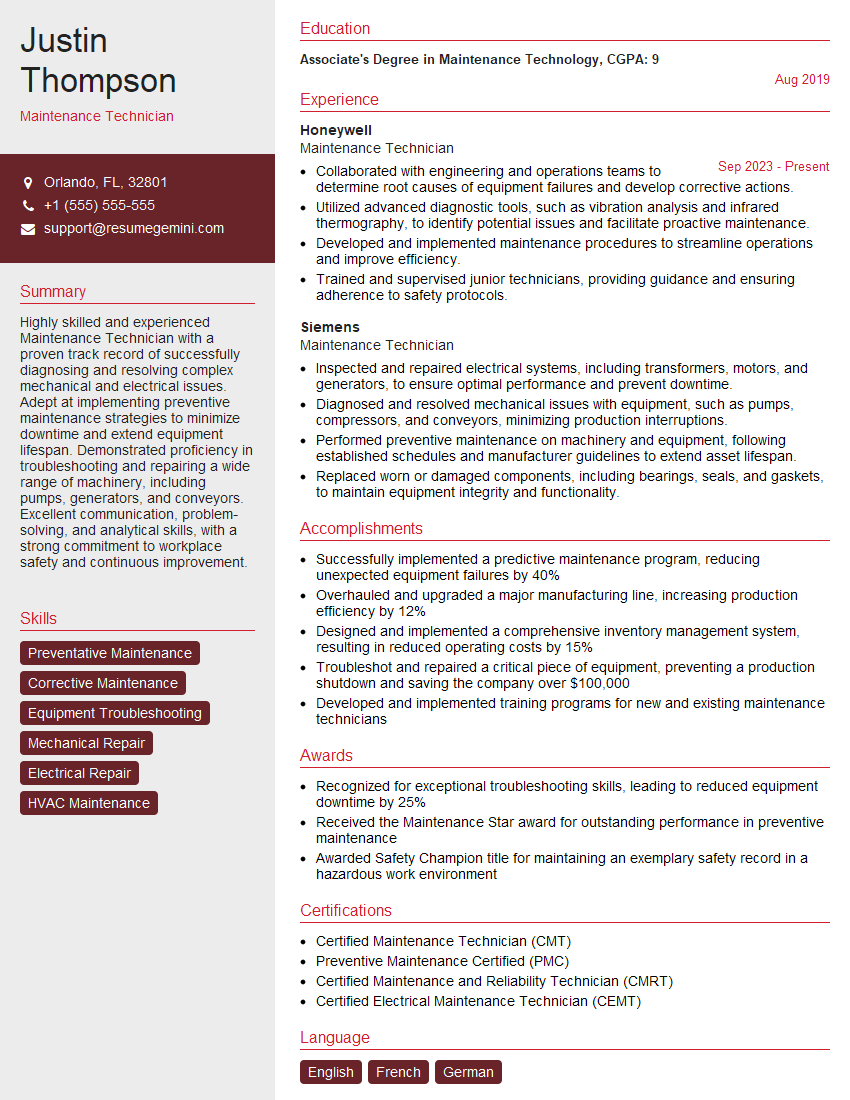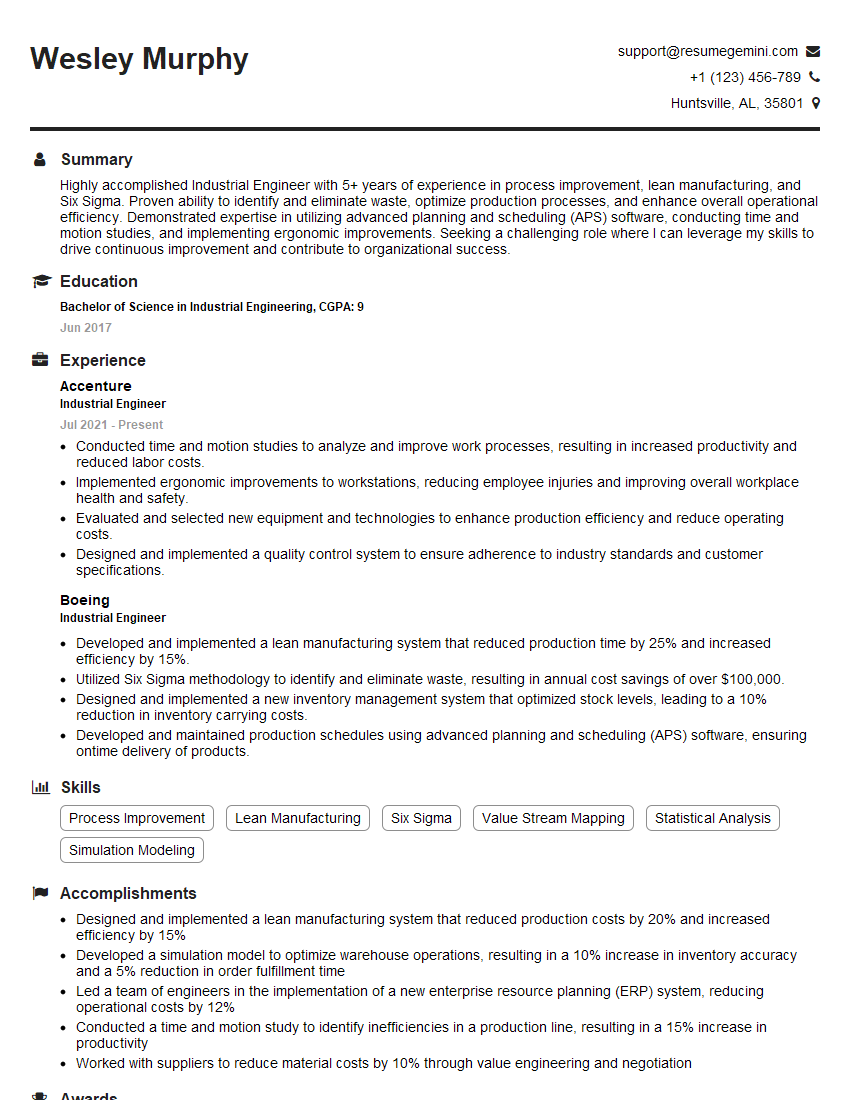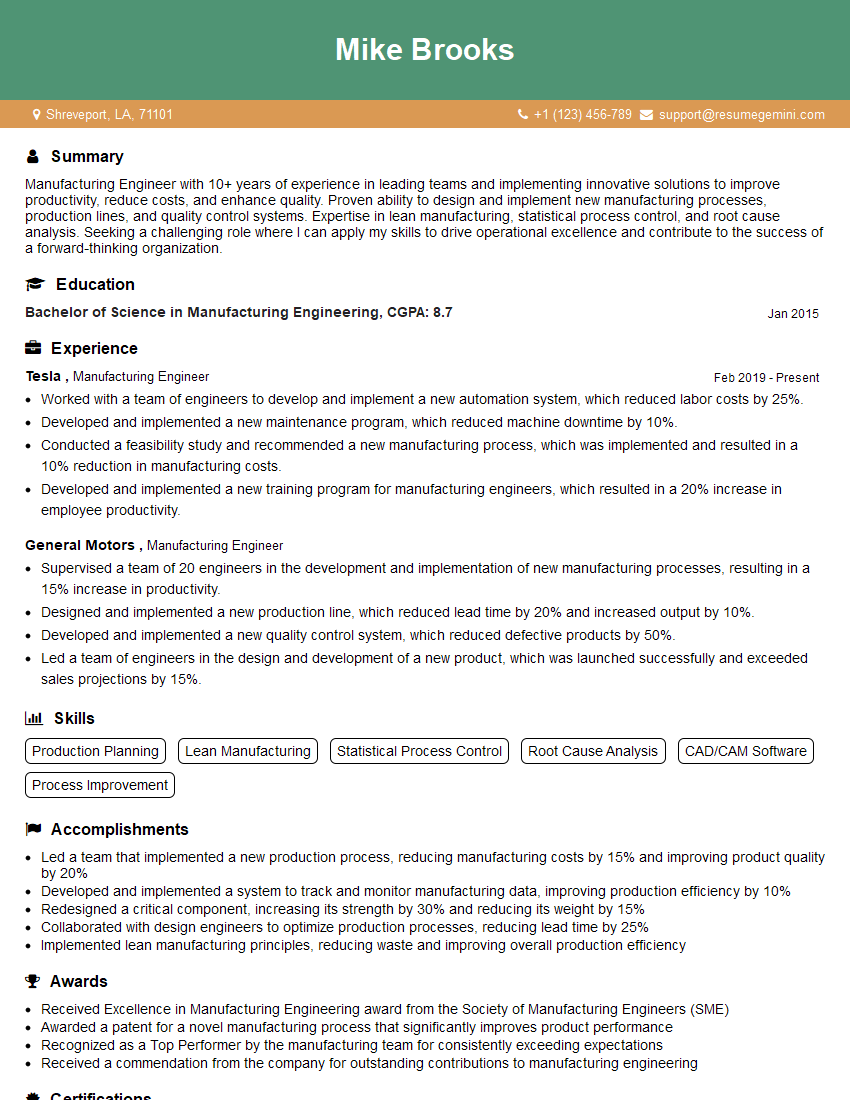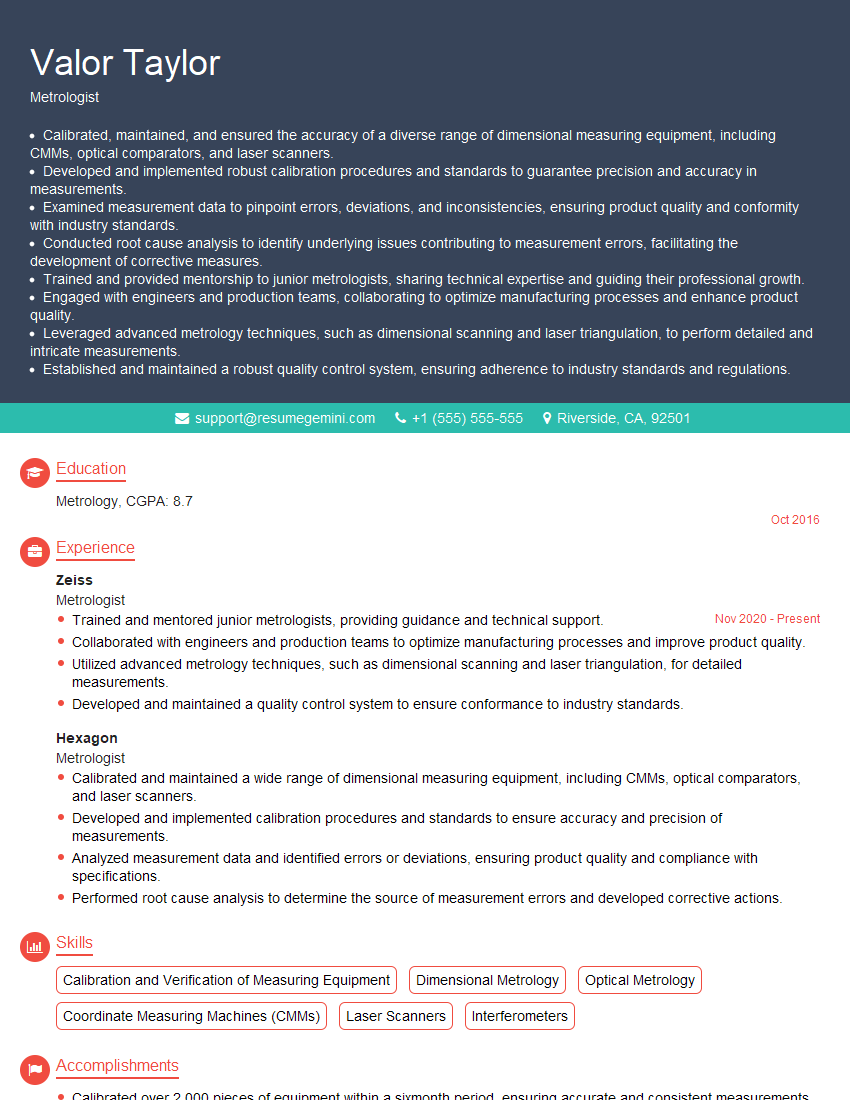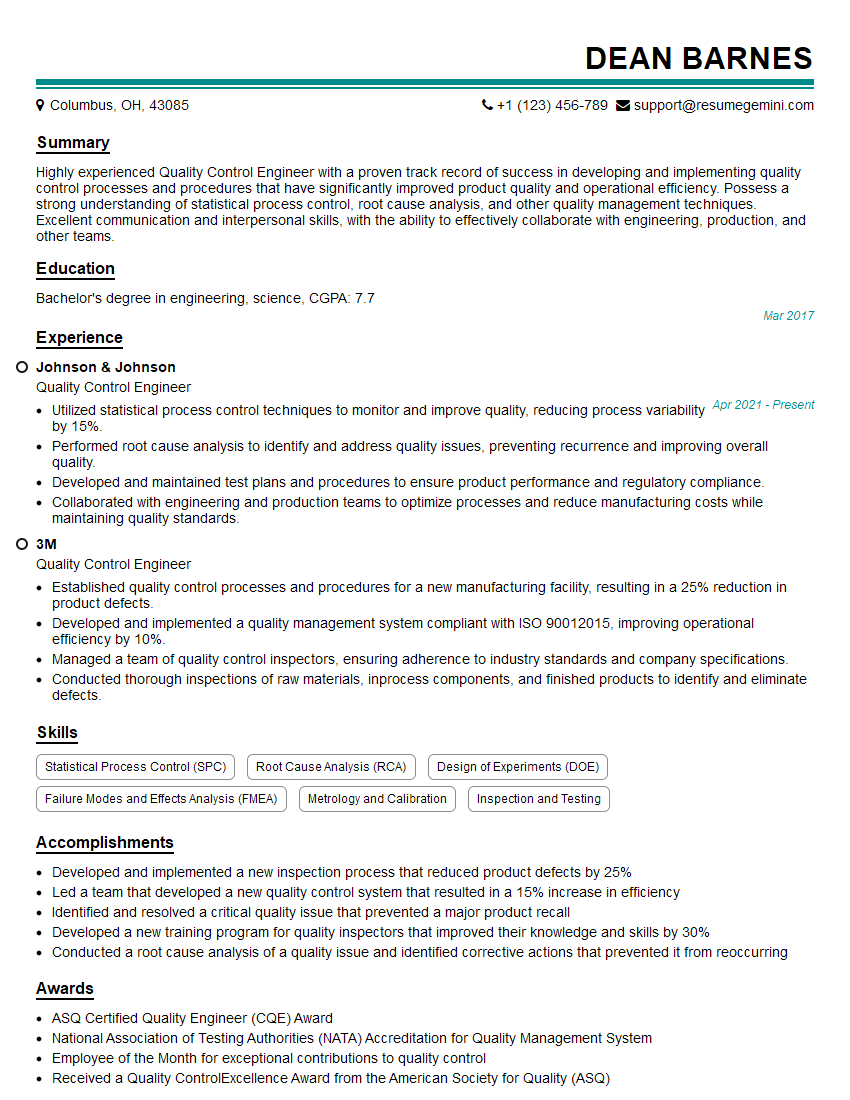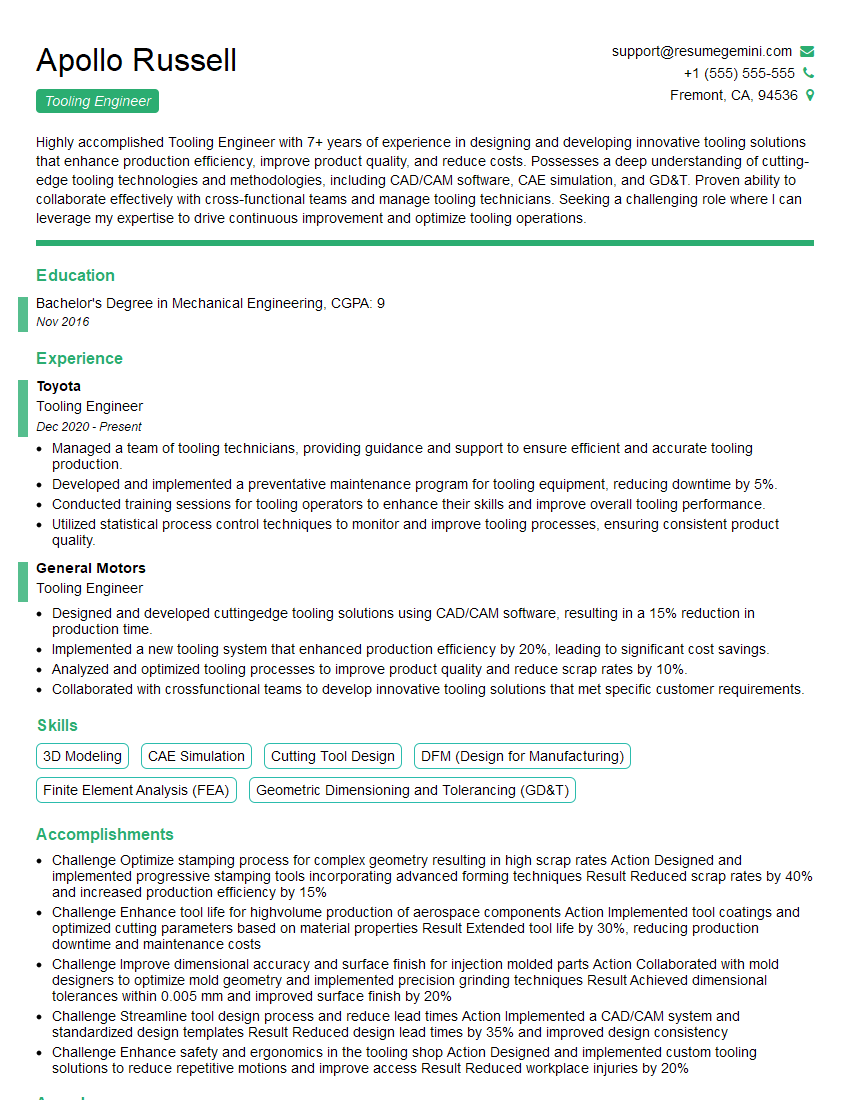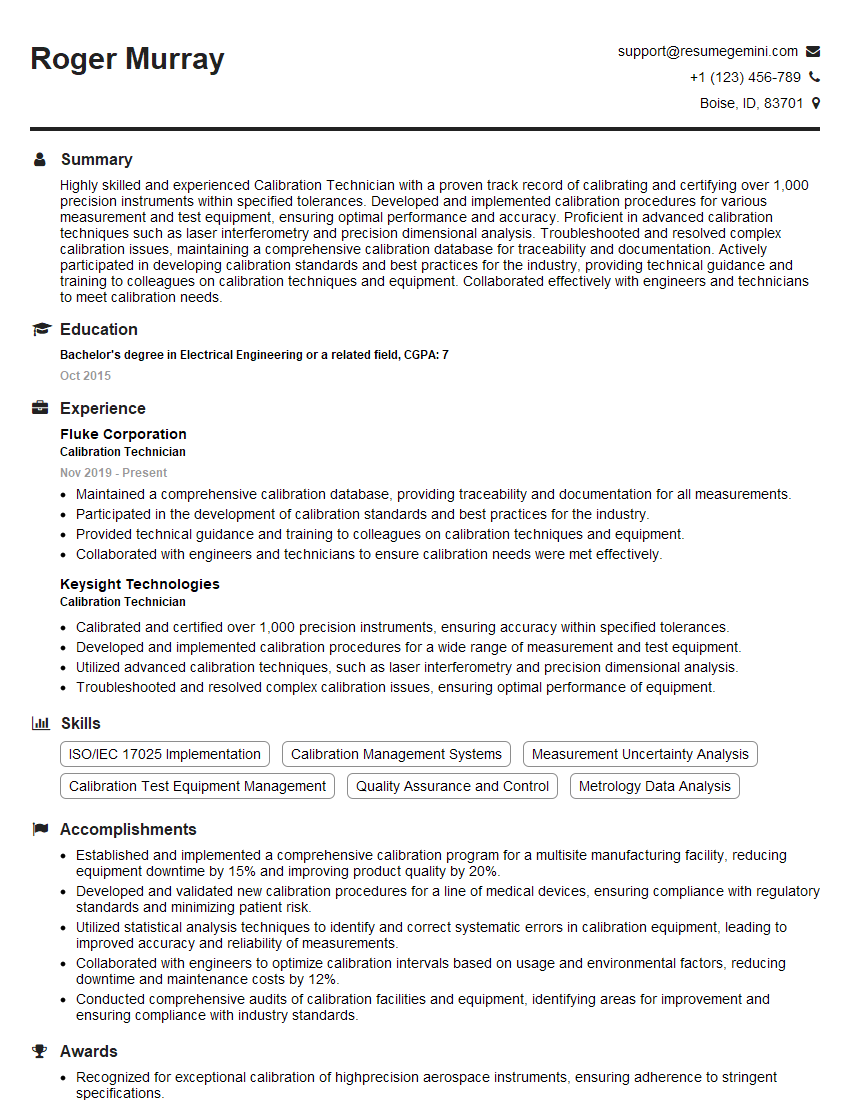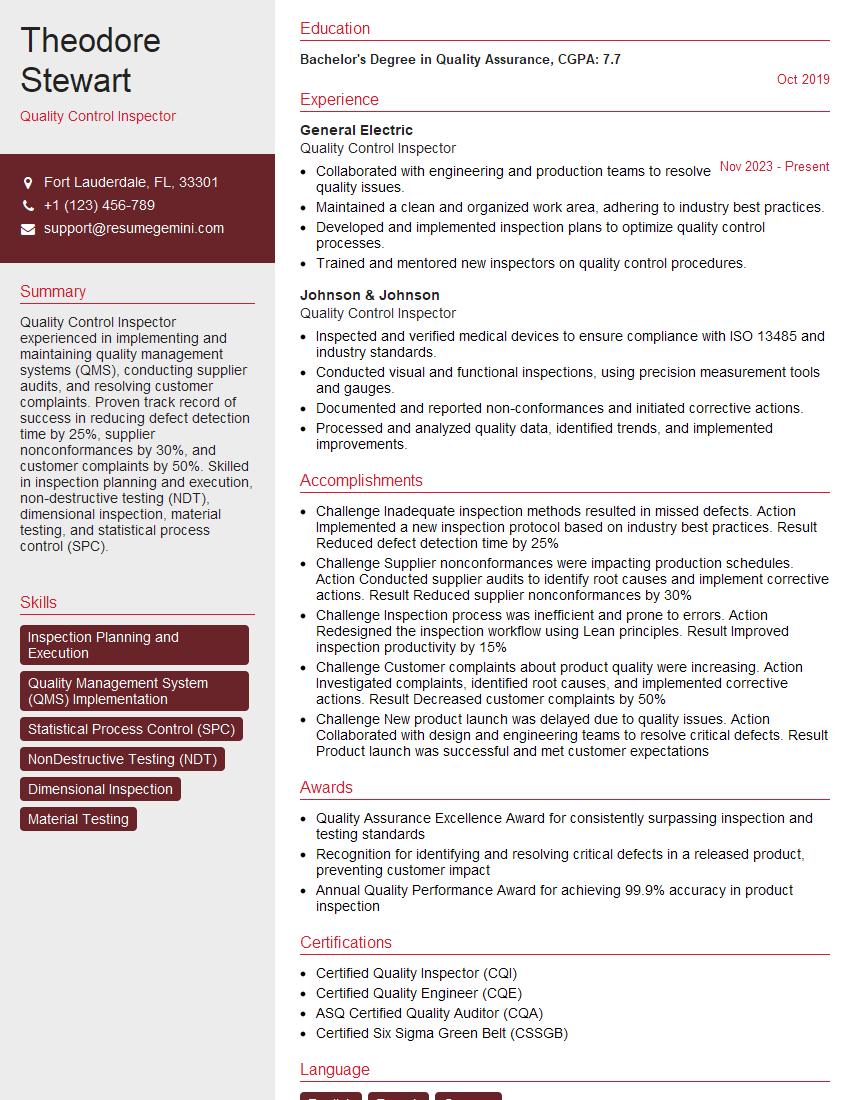The right preparation can turn an interview into an opportunity to showcase your expertise. This guide to Tool Selection and Inspection interview questions is your ultimate resource, providing key insights and tips to help you ace your responses and stand out as a top candidate.
Questions Asked in Tool Selection and Inspection Interview
Q 1. Explain the process of selecting the right tool for a specific manufacturing task.
Selecting the right tool for a manufacturing task is crucial for efficiency, safety, and product quality. It’s a multi-step process that goes beyond simply choosing the most powerful or readily available option. Think of it like choosing the right tool for a home repair – you wouldn’t use a hammer to screw in a screw!
- Define the task: Begin by precisely defining the manufacturing operation. What material are you working with? What are the dimensions and tolerances required? What is the desired surface finish? What is the production volume?
- Identify potential tools: Based on the task definition, research and identify a range of tools that could potentially perform the operation. Consider factors like speed, accuracy, ease of use, and cost.
- Evaluate tool capabilities: Carefully analyze the specifications of each potential tool. Compare their power, precision, and suitability for the specific material and tolerances. Look for certifications and compliance with relevant safety standards.
- Consider ergonomics and safety: Choose a tool that’s ergonomic and comfortable to use to minimize operator fatigue and risk of injury. Ensure the tool meets all relevant safety standards and is properly maintained.
- Cost-benefit analysis: Compare the initial cost of the tool with its operational costs, including maintenance and replacement parts. Evaluate its long-term cost-effectiveness considering the production volume and expected lifespan.
- Trial and selection: Where feasible, conduct a trial run with the shortlisted tools. This allows for hands-on evaluation and confirmation of the tool’s performance before full-scale implementation.
For example, when drilling a precise hole in a delicate aluminum component, a high-precision drill press with the appropriate drill bit size would be preferable over a hand drill, which might lead to inaccuracies or damage.
Q 2. Describe different types of inspection methods and their applications.
Inspection methods are crucial for quality control and ensuring products meet specifications. Different methods cater to various needs and material properties.
- Visual Inspection: The simplest method, involving direct observation of the part for surface defects, dimensions, and overall quality. It’s inexpensive but subjective and limited for fine details.
- Dimensional Inspection: Uses measuring instruments like calipers, micrometers, and CMMs (Coordinate Measuring Machines) to verify dimensions and tolerances. This is precise and objective but can be time-consuming for complex parts.
- Non-destructive Testing (NDT): Used to detect internal flaws without damaging the part. Methods include ultrasonic testing, radiographic testing, and magnetic particle inspection. This is crucial for detecting hidden defects in critical components.
- Destructive Testing: Involves testing to failure to determine the material’s strength, durability, and other properties. Examples include tensile testing, impact testing, and hardness testing. This method is essential for understanding material properties and validating designs but requires sample destruction.
- Optical Inspection: Uses microscopes or other optical instruments to examine surface features and microstructure at higher magnifications than visual inspection. This is particularly useful for detecting minute flaws or analyzing surface finishes.
For instance, visual inspection is suitable for checking the overall appearance of a painted car body, while dimensional inspection is necessary for ensuring the accuracy of the engine’s internal components. NDT techniques such as ultrasonic testing would be used to check for cracks in a weld joint in a pressure vessel.
Q 3. How do you determine the appropriate tolerance levels for a given part?
Determining appropriate tolerance levels is a critical step in design and manufacturing, ensuring functionality and interchangeability while considering manufacturing limitations. It involves a balance between precision and cost.
- Functional Requirements: The primary driver is the part’s function. Tight tolerances are needed for precision components where minute deviations can affect performance (e.g., a bearing). Looser tolerances are acceptable for less critical components (e.g., a non-load-bearing plastic housing).
- Manufacturing Capabilities: The chosen manufacturing process dictates achievable tolerances. CNC machining allows tighter tolerances than casting or forging. Consider the process’s inherent variations and capabilities.
- Material Properties: The material’s inherent variability influences tolerance setting. Some materials are more prone to variations during processing.
- Cost Considerations: Tighter tolerances generally increase manufacturing costs. Finding the optimal balance between required precision and cost-effectiveness is crucial.
- Industry Standards: Relevant industry standards and specifications often dictate acceptable tolerance ranges (e.g., ISO standards).
For example, a turbine blade in a jet engine requires extremely tight tolerances due to its critical function and high operational speeds. On the other hand, a plastic bottle cap might have much looser tolerances because minor dimensional variations won’t significantly affect its performance.
Q 4. What are the key considerations when selecting measuring instruments?
Selecting measuring instruments involves careful consideration of several factors to ensure accuracy and reliability. The wrong instrument can lead to costly errors.
- Accuracy and Precision: The instrument’s stated accuracy and precision must meet or exceed the required tolerance of the part being measured. Accuracy refers to how close a measurement is to the true value, while precision refers to the repeatability of measurements.
- Resolution: The smallest increment the instrument can measure. It needs to be fine enough to capture the required level of detail.
- Measurement Range: The instrument must cover the range of dimensions to be measured.
- Type of Measurement: Different instruments measure different parameters: length, diameter, angle, surface roughness, etc. Select the right type for the specific measurement need.
- Ease of Use and Calibration: Choose instruments that are user-friendly and easy to calibrate. Regular calibration is essential for maintaining accuracy.
- Cost and Availability: Consider the instrument’s cost, availability of service, and spare parts.
For example, a micrometer is ideal for precise measurement of small parts, while a caliper is suitable for larger parts. A CMM is necessary for complex three-dimensional measurements, and optical comparators provide accurate measurements of shapes and profiles.
Q 5. Explain the concept of Gage R&R and its importance.
Gage Repeatability and Reproducibility (Gage R&R) is a statistical method used to assess the variability of a measurement system. It determines how much of the total variation in measurements is due to the measurement process itself (gage variation) versus the actual variation in the parts being measured (part variation). This is critical because an unreliable measurement system can lead to incorrect conclusions about product quality.
The study involves multiple operators measuring the same parts multiple times. The data is then analyzed to determine the repeatability (variation from repeated measurements by the same operator) and reproducibility (variation between different operators using the same gage). The total Gage R&R is the combined variation from both sources. A significant Gage R&R indicates the measurement system is unreliable and needs improvement.
The importance lies in ensuring that any observed variations in parts are truly due to differences in the parts themselves and not artifacts of the measurement process. A high Gage R&R suggests that the measurement system is introducing significant noise, obscuring the real variation in the parts, potentially leading to incorrect decisions about product acceptance or rejection.
Q 6. How do you handle discrepancies found during inspection?
Handling discrepancies found during inspection requires a systematic approach to identify the root cause and prevent recurrence.
- Verification: First, independently verify the discrepancy. Repeat the measurement using different instruments or operators to confirm the findings.
- Root Cause Analysis: Investigate the possible causes. Consider factors like faulty equipment, incorrect procedures, operator error, material defects, or process issues. Tools like Pareto charts or fishbone diagrams can help organize and analyze the potential causes.
- Corrective Actions: Implement appropriate corrective actions to address the root cause. This might involve recalibrating equipment, retraining operators, modifying processes, or changing materials.
- Documentation: Meticulously document all steps, including the initial discrepancy, the verification process, the root cause analysis, the corrective actions taken, and the verification of the effectiveness of those actions.
- Preventative Actions: Implement preventative measures to avoid similar discrepancies in the future. This might involve implementing better quality control procedures, improving process monitoring, or improving operator training.
For example, if a batch of parts fails dimensional inspection, a thorough investigation might reveal a machine malfunction causing inconsistent processing. Corrective actions might involve repairing the machine and inspecting all parts produced during the period of malfunction.
Q 7. Describe your experience with Statistical Process Control (SPC).
Statistical Process Control (SPC) is a powerful technique for monitoring and controlling manufacturing processes to improve quality and reduce variability. I have extensive experience using SPC tools and techniques in various manufacturing settings.
My experience includes implementing control charts (e.g., X-bar and R charts, p-charts, c-charts) to monitor key process parameters. I’ve used these charts to detect trends, shifts, and unusual variations in the process. This allows for timely intervention to prevent defects and maintain consistency. I’m proficient in analyzing control chart data to identify assignable causes of variation and implementing corrective actions to address them.
Furthermore, I’ve utilized capability analysis (Cp, Cpk) to assess the process’s ability to meet specified requirements. This helps to determine if the process is capable of consistently producing parts within the desired tolerances. Based on these analyses, I’ve been involved in process improvement projects aimed at reducing variability and enhancing process capability. My experience also includes using data analysis software to manage and interpret large data sets related to SPC.
For instance, I helped a manufacturing plant reduce scrap rates by 15% by implementing a robust SPC program that identified and corrected a previously undetected trend in a critical process parameter. This demonstrates the value of proactive process monitoring and control.
Q 8. How do you ensure the accuracy and reliability of inspection equipment?
Ensuring the accuracy and reliability of inspection equipment is paramount for maintaining quality control. It’s a multi-faceted process involving calibration, preventative maintenance, and rigorous testing. Think of it like regularly servicing your car – neglecting it leads to breakdowns and inaccurate readings.
Calibration: All measuring equipment needs regular calibration against known standards. For instance, a micrometer might be calibrated against a gauge block of precisely known dimensions. Calibration certificates document the accuracy and traceability to national standards.
Preventative Maintenance: This includes regular cleaning, lubrication (where applicable), and visual inspections for damage. A damaged caliper, for example, could lead to inaccurate measurements. A preventative maintenance schedule ensures that problems are caught before they lead to significant inaccuracies.
Testing and Verification: Periodically, the equipment’s accuracy is tested using known standards or reference samples. This confirms that the calibration is holding and that the equipment remains reliable. For example, we might use a precision gauge block to check the accuracy of our micrometers after a cleaning.
Failure to perform these steps can lead to significant errors in measurements, resulting in defective products, wasted materials, and potential safety hazards.
Q 9. What are your preferred methods for documenting inspection results?
Documenting inspection results effectively is crucial for traceability, accountability, and future analysis. My preferred methods combine digital and physical records to ensure a comprehensive audit trail.
Digital Documentation: I utilize software specifically designed for quality control and inspection. These programs often allow for direct data entry from measuring instruments, generating reports with charts and graphs. This method offers quick access to data and efficient reporting. We typically use a system that integrates directly with our production line.
Physical Documentation: Even with digital records, maintaining physical copies of inspection reports, including photographs or sketches of any defects, is essential for compliance and backup. This provides a clear record, especially helpful during audits or if the digital system encounters issues.
Data Integrity: Regardless of the method, ensuring data integrity is vital. This involves clear labeling, proper data entry procedures, and using a version control system to track changes and avoid errors.
A well-documented inspection process provides a robust record of the quality of our work and ensures we can track down issues easily if necessary.
Q 10. How do you manage and resolve tool failures or malfunctions?
Managing tool failures or malfunctions requires a systematic approach that combines immediate response with preventative measures.
Immediate Response: Upon detecting a malfunction, the tool is immediately removed from service to prevent further issues. A clear incident report is filed, detailing the malfunction, the date, time, and the affected tool. This avoids repeated use of the faulty equipment.
Troubleshooting and Repair: Depending on the tool’s complexity, troubleshooting may involve simple repairs (like replacing a worn part) or sending it to a specialized repair center. We maintain a log of repairs to understand recurring issues.
Root Cause Analysis: For recurring failures, a thorough root cause analysis is performed to determine the underlying cause, whether it’s operator error, faulty maintenance, or a design flaw in the tool. This helps prevent future incidents.
Preventative Measures: Implementing preventative measures, such as regular calibration and maintenance schedules, is essential to reducing the frequency of tool failures.
For example, a consistently failing micrometer might reveal a problem with the clamping mechanism, prompting a design review or a change in the maintenance procedure.
Q 11. Explain your experience with different types of measuring tools (e.g., calipers, micrometers).
I have extensive experience using a variety of measuring tools, including calipers, micrometers, dial indicators, and height gauges. My proficiency extends beyond simply using these tools; I understand their limitations, accuracy levels, and proper applications.
Calipers: I’m proficient in using both vernier and digital calipers for measuring both internal and external dimensions. I understand how to accurately read both types and recognize the limitations of their precision.
Micrometers: I’m skilled in using micrometers for precise measurements, understanding the importance of proper technique to avoid measurement errors. I know how to select the appropriate micrometer for the task at hand, considering the range of measurements needed.
Other Tools: My experience includes using dial indicators for checking surface flatness and run-out, as well as height gauges for precision height measurements. I understand the importance of proper setup and reading these instruments accurately.
In my previous role, I regularly used these tools to inspect critical dimensions on precision-machined parts, ensuring they met the specified tolerances. My experience encompasses both manual and automated measuring techniques.
Q 12. How do you interpret engineering drawings and specifications related to tooling and inspection?
Interpreting engineering drawings and specifications is fundamental to my role. I’m adept at understanding GD&T (Geometric Dimensioning and Tolerancing) symbols and their implications for tooling and inspection. Think of it like reading a detailed recipe – it guides the process and ensures the final product meets expectations.
GD&T Interpretation: I can accurately interpret symbols like position, perpendicularity, and runout, understanding their tolerances and implications for acceptable part variations. This helps me select the appropriate inspection methods and tools.
Material Specifications: I understand how material specifications influence tool selection. For instance, inspecting a hardened steel part requires different tools and methods than inspecting a softer aluminum part.
Dimensional Tolerances: I can interpret tolerances on engineering drawings, understanding the allowable variation for each dimension. This knowledge is critical for accepting or rejecting parts based on their dimensional accuracy.
For example, I recently used a CMM to inspect a part with tight tolerances on its position and flatness, ensuring it met the specifications outlined in the engineering drawing. This involved understanding the GD&T symbols and selecting the appropriate measuring strategy for the CMM.
Q 13. What is your experience with CMM (Coordinate Measuring Machine) operation?
I have significant experience operating a Coordinate Measuring Machine (CMM). My skills extend from basic operation and programming to complex measurement strategies and data analysis. A CMM is a sophisticated tool; proficiency requires both technical knowledge and precision.
Programming and Operation: I’m proficient in programming CMMs using various software packages, including creating measurement routines, probing strategies, and generating reports. I am familiar with both touch-trigger and scanning probe systems.
Data Analysis: I can analyze CMM data to identify deviations from specifications, generate reports, and interpret statistical process control (SPC) charts. This allows for proactive identification of trends and problems.
Calibration and Maintenance: I understand the importance of CMM calibration and preventative maintenance to ensure accuracy and reliability. I can perform basic maintenance tasks and troubleshoot minor issues.
In a previous role, I used a CMM to inspect complex aerospace components with extremely tight tolerances. The CMM’s ability to measure multiple points precisely and generate detailed reports was crucial for ensuring quality control.
Q 14. How do you determine the root cause of recurring inspection failures?
Determining the root cause of recurring inspection failures requires a structured and methodical approach, often involving the application of root cause analysis (RCA) techniques.
Data Collection: The first step involves gathering comprehensive data on the failures. This includes details on the failed parts, the inspection methods used, the operators involved, and any environmental factors that might have played a role. A well-structured data collection process is crucial.
5 Whys Analysis: A popular RCA technique is the ‘5 Whys’ – repeatedly asking ‘why’ to delve deeper into the cause. This helps to peel back the layers of superficial causes to reach the underlying root cause. For example: Why did the part fail inspection? Because the dimension was out of tolerance. Why was the dimension out of tolerance? Because the machine was misaligned. Why was the machine misaligned? Because it wasn’t properly calibrated.
Pareto Analysis: This technique helps identify the ‘vital few’ causes contributing to the majority of the problems. By focusing on these key causes, resources can be targeted effectively.
Process Improvement: Once the root cause is identified, implementing process improvements can prevent future failures. This might involve retraining operators, improving machine maintenance procedures, or modifying the manufacturing process itself.
For example, recurring failures in a specific dimension on a machined part might lead us to investigate the machine’s tooling, its maintenance schedule, or even the programming of the CNC machine itself.
Q 15. Describe your experience with different types of inspection reports.
My experience encompasses a wide range of inspection reports, from simple check sheets for visual inspections to complex, multi-page reports detailing intricate dimensional measurements and material analyses. I’m familiar with reports generated by various methods, including manual data entry, automated systems using CMMs (Coordinate Measuring Machines) and optical comparators, and software-generated reports from automated inspection systems.
For example, I’ve worked with First Article Inspection Reports (FAIRs), which verify that the initial production run meets specifications. These are crucial for ensuring quality from the outset. I’ve also generated and reviewed In-Process Inspection Reports, used to monitor quality throughout the manufacturing process, and Final Inspection Reports, which determine the final acceptability of the product. These reports often include statistical process control (SPC) charts, detailed measurements with tolerances, and photographic evidence. The format and level of detail vary according to the industry standards (e.g., AS9100 for aerospace) and the complexity of the product.
The key differentiator between these reports isn’t just the timing but also the specific data collected. A FAIR will focus heavily on confirming dimensions and material properties against the design specifications. In-process reports might track critical characteristics throughout various stages, looking for trends and potential issues. Finally, the final report will summarize everything and determine the ultimate disposition of the part or product.
Career Expert Tips:
- Ace those interviews! Prepare effectively by reviewing the Top 50 Most Common Interview Questions on ResumeGemini.
- Navigate your job search with confidence! Explore a wide range of Career Tips on ResumeGemini. Learn about common challenges and recommendations to overcome them.
- Craft the perfect resume! Master the Art of Resume Writing with ResumeGemini’s guide. Showcase your unique qualifications and achievements effectively.
- Don’t miss out on holiday savings! Build your dream resume with ResumeGemini’s ATS optimized templates.
Q 16. How do you prioritize inspection tasks in a high-volume manufacturing environment?
Prioritizing inspection tasks in a high-volume manufacturing environment requires a strategic approach that balances risk, cost, and production efficiency. I use a risk-based prioritization method, combining criticality analysis and statistical process control (SPC) data. This involves:
- Identifying critical characteristics: These are features that, if defective, would severely impact product performance or safety. These get top priority.
- Analyzing historical data: Reviewing past inspection results helps identify parts or processes with a higher defect rate. These areas need more frequent inspection.
- Employing SPC: Control charts track process variability, allowing for the identification of trends and potential out-of-control situations. This data guides inspection frequency and focus.
- Utilizing sampling plans: Instead of 100% inspection (which is often impractical and costly), statistical sampling plans are employed, determining the optimal sample size based on acceptable quality levels (AQLs) and the risk of accepting bad parts.
- Automation where possible: Automating inspection processes reduces lead time and improves consistency, freeing human inspectors to focus on more critical tasks.
For instance, in a scenario producing circuit boards, solder joint integrity might be a critical characteristic requiring 100% automated optical inspection. However, cosmetic defects might be inspected through statistical sampling, relying on AQLs.
Q 17. How do you handle situations where inspection results are outside of acceptable tolerances?
When inspection results fall outside acceptable tolerances, a systematic investigation is crucial. This is not simply about rejecting parts but about understanding the root cause and implementing corrective actions to prevent recurrence.
- Verification: First, the inspection results are verified using secondary methods or by a different inspector to eliminate errors in measurement or data interpretation.
- Root cause analysis: This is the most critical step. Tools like 5 Whys, Fishbone diagrams, or Pareto charts can help identify the underlying causes of the deviation. This might point towards issues in the tooling, the manufacturing process, the materials used, or operator error.
- Corrective action: Based on the root cause analysis, corrective actions are implemented. These could range from simple adjustments to machine settings or operator training to more substantial changes like replacing worn tools or revising the manufacturing process.
- Containment: While corrective actions are implemented, steps are taken to prevent the defective parts from reaching the customer. This might involve quarantining suspect parts or implementing additional in-process inspections.
- Documentation: All findings, corrective actions, and verifications are meticulously documented, including photographs and updated inspection reports.
For example, if the dimensions of a machined part consistently exceed the upper tolerance limit, the root cause could be tool wear, incorrect machine settings, or improper material handling. The corrective action might involve replacing the cutting tool, recalibrating the machine, or tightening quality controls on incoming materials.
Q 18. Explain your understanding of dimensional metrology.
Dimensional metrology is the science of measurement of geometric quantities. It involves the use of various instruments and techniques to accurately and precisely determine the dimensions, shapes, and forms of objects. This is crucial for ensuring that manufactured parts meet design specifications. It encompasses various aspects:
- Measurement techniques: This includes using various instruments like CMMs (Coordinate Measuring Machines), optical comparators, laser scanners, and profilometers. Each technique offers different levels of accuracy and suitability depending on the part’s geometry and material.
- Data analysis: The collected data is then analyzed to determine whether it conforms to the specifications. Statistical methods are used to assess accuracy and precision, identify trends, and determine overall part quality.
- Uncertainty analysis: It’s crucial to understand and quantify the uncertainty associated with each measurement. This uncertainty takes into account factors like instrument resolution, operator skill, environmental conditions, and measurement methods.
- Calibration and traceability: All measuring instruments must be regularly calibrated to a traceable standard to maintain accuracy and ensure reliability of measurement data. This ensures that measurements are consistent and comparable.
An example of dimensional metrology in practice is using a CMM to measure the dimensions of a complex aerospace component to ensure that it meets the tight tolerances required for proper functioning.
Q 19. Describe your experience with various inspection software and databases.
My experience with inspection software and databases includes working with both standalone metrology software packages and integrated manufacturing execution systems (MES). I’m proficient in using software that controls CMMs, optical comparators, and vision systems, allowing for automated data acquisition and analysis. I’ve also worked extensively with database systems, such as SQL-based solutions, to manage and analyze large datasets from various inspection sources.
Specific software experience includes [mention specific software packages, e.g., PolyWorks, PC-DMIS, Q-DAS]. This includes importing CAD models for comparison with measured data, generating inspection reports, and analyzing statistical process control (SPC) charts. Database experience includes managing and querying databases to track inspection results, identify trends, and generate reports for continuous improvement initiatives.
The ability to effectively use these tools enables efficient data management, streamlined reporting, and detailed analysis leading to better decision-making in quality control.
Q 20. How do you ensure traceability throughout the inspection process?
Traceability throughout the inspection process is essential for ensuring accountability and facilitating quality investigations. It involves establishing a clear and unbroken chain of custody for all inspected parts and related data. This is achieved through several key strategies:
- Unique identification: Each part should have a unique identification number, traceable from raw material to final inspection. This number is recorded at each stage of the process.
- Documented procedures: Standardized procedures for inspection, data recording, and report generation ensure consistency and maintain traceability. This includes documented calibration procedures for all instruments.
- Automated data capture: Using automated inspection systems eliminates manual data entry errors and provides a reliable audit trail.
- Electronic record keeping: Using electronic databases and document management systems provides secure and readily accessible records, preserving data integrity and simplifying audits.
- Calibration certificates: Maintaining records of calibration certificates for all measuring instruments proves that the equipment was functioning correctly during the inspection process.
Imagine a scenario where a defective part is discovered in the field. With proper traceability, we can easily identify which batch the part came from, the specific inspector, the date and time of inspection, and the tools and equipment used. This information is crucial in identifying the root cause of the defect and preventing similar issues from occurring in the future.
Q 21. What are your strategies for continuous improvement in tool selection and inspection processes?
Continuous improvement in tool selection and inspection processes is a critical aspect of maintaining high quality and efficiency. My strategies for continuous improvement involve:
- Regular process reviews: Periodic review of inspection procedures, identifying areas for improvement in efficiency, accuracy, or cost-effectiveness.
- Data analysis: Closely analyzing inspection data to identify trends, potential problems, and opportunities for optimization. Statistical process control (SPC) charts are invaluable here.
- Technology upgrades: Exploring and adopting new technologies, such as advanced metrology equipment or improved software, can enhance accuracy, speed, and efficiency.
- Operator training: Providing continuous training to inspection personnel to improve their skills and knowledge, ensuring consistent and accurate results.
- Benchmarking: Comparing performance against industry best practices and other organizations to identify areas for improvement.
- Kaizen events: Organizing focused workshops or Kaizen events involving cross-functional teams to brainstorm and implement solutions for specific problems.
For example, analyzing inspection data might reveal that a particular type of cutting tool is wearing out prematurely, leading to increased scrap rates. This could prompt an investigation into alternative tools or changes in machining parameters, reducing costs and improving efficiency. Implementing continuous improvement ensures the inspection process remains effective, efficient and adapted to evolving needs.
Q 22. How familiar are you with industry standards and regulations (e.g., ISO 9001)?
My familiarity with industry standards and regulations like ISO 9001 is extensive. I understand that adherence to these standards is crucial for maintaining consistent quality and reliability in tool selection and inspection processes. ISO 9001, for example, provides a framework for quality management systems, focusing on aspects like risk management, continuous improvement, and customer satisfaction. This translates directly to tool selection by ensuring we choose tools that meet specified requirements and are calibrated correctly, and to inspection by ensuring our procedures are documented, controlled, and auditable. I’ve personally worked on projects that required full compliance with ISO 9001, implementing procedures for tool verification, calibration records, and non-conformance reporting, all of which directly impact the accuracy and traceability of our inspection processes. My experience also extends to other relevant standards such as those specific to particular industries (e.g., aerospace, automotive) which often have even more stringent requirements.
Q 23. Describe a time you had to select a tool under pressure or with limited resources.
During a critical production run, a key inspection tool malfunctioned. We needed a replacement immediately, but our usual supplier had a lengthy lead time. Under this pressure, I leveraged my knowledge of alternative tools and suppliers. I identified a comparable tool from a secondary supplier that, while slightly more expensive, could be delivered within 24 hours. This involved a rapid assessment of its specifications, ensuring compatibility with our existing system, and securing management approval for the expedited purchase. Limited resources meant we had to creatively manage the budget and find a fast solution without compromising quality or safety. The alternative tool passed our validation tests, preventing significant production delays and potential financial losses. This experience highlighted the importance of having backup plans and a broad understanding of available tooling options.
Q 24. How do you stay up-to-date with the latest advancements in tooling and inspection technologies?
Staying current with advancements in tooling and inspection technologies requires a multi-faceted approach. I regularly attend industry conferences and webinars to learn about new developments. I subscribe to relevant trade publications and journals. Furthermore, I actively participate in online professional networks and forums, engaging in discussions and knowledge sharing with other experts. This allows me to stay informed about new materials, improved sensor technologies, advanced software for data analysis, and innovative automation solutions. I also regularly assess the potential benefits of new technologies for our processes, performing thorough cost-benefit analyses to ensure that any upgrades are strategic and aligned with our goals. For example, I recently investigated the integration of AI-powered image analysis for our automated inspection line, potentially increasing both speed and accuracy significantly.
Q 25. Describe your experience with preventative maintenance of inspection equipment.
Preventative maintenance of inspection equipment is paramount to ensure accuracy and reliability. My approach involves establishing a structured maintenance schedule, based on manufacturer recommendations and our own usage data. This schedule includes regular calibrations using traceable standards, visual inspections for wear and tear, and functional tests to verify performance. We maintain meticulous records of all maintenance activities, including calibration certificates and any necessary repairs. We also utilize predictive maintenance techniques, using sensor data to anticipate potential issues before they impact operations. For example, we monitor vibration levels in our CMM (Coordinate Measuring Machine) to detect early signs of bearing wear, allowing for proactive intervention and preventing costly downtime. This proactive approach minimizes the risk of inaccurate measurements and ensures the long-term reliability of our equipment.
Q 26. How do you ensure the proper training and competency of inspection personnel?
Ensuring proper training and competency of inspection personnel is vital for the quality and integrity of our work. Our training program includes both classroom instruction and hands-on experience, covering theoretical aspects like metrology principles, practical skills in using various inspection tools, and understanding relevant standards and procedures. We use a competency-based approach, assessing personnel through practical examinations and regular performance reviews. This ensures that individuals demonstrate proficiency before independently performing inspections. We also provide ongoing professional development opportunities, such as specialized training on new technologies or advanced inspection techniques. Regular refresher courses maintain consistent high standards across the team and keep everyone informed of best practices and any changes in regulations or procedures.
Q 27. Explain your approach to problem-solving in the context of tool selection and inspection.
My problem-solving approach in tool selection and inspection is systematic and data-driven. I use a structured process that starts with clearly defining the problem and its root cause. This often involves analyzing the specific requirements of the task, including accuracy, precision, speed, and cost considerations. Then, I evaluate potential solutions, comparing various tools and techniques against these requirements. This evaluation may include factors such as tool cost, maintenance requirements, operator skill level needed, and environmental considerations. Data analysis plays a crucial role, enabling me to objectively compare performance metrics and make informed decisions. Finally, I implement the chosen solution and monitor its performance, using feedback to refine the process and continuously improve our approach. This iterative approach allows for adjustments and optimization as needed. For example, if we find a specific tool consistently produces inconsistent results, this systematic approach would help identify the cause – be it improper calibration, operator error, or a design flaw – allowing for corrective actions.
Key Topics to Learn for Tool Selection and Inspection Interview
- Tool Selection Criteria: Understanding factors like material compatibility, required precision, safety regulations, and cost-effectiveness when choosing tools for a specific task.
- Inspection Techniques: Mastering visual inspection, dimensional checks, functional testing, and the use of measuring instruments (calipers, micrometers, etc.) for verifying tool quality and functionality.
- Preventive Maintenance & Calibration: Knowing the importance of regular tool maintenance, lubrication, and calibration schedules to ensure accuracy and longevity, minimizing downtime and safety risks.
- Safety Procedures & Regulations: Familiarity with relevant safety standards (OSHA, etc.) and proper handling procedures to prevent accidents and injuries when using and inspecting tools.
- Troubleshooting & Problem Solving: Developing the ability to identify the root cause of tool malfunctions, propose solutions, and implement corrective actions efficiently.
- Documentation & Record Keeping: Understanding the importance of meticulous record-keeping for tool inspections, maintenance, and calibration, adhering to company policies and industry best practices.
- Different Tool Types & Applications: Gaining expertise in the various types of tools used in your specific field (e.g., hand tools, power tools, measuring tools, specialized equipment) and their appropriate applications.
- Impact of Tool Selection on Project Outcomes: Recognizing how the correct tool selection directly impacts project quality, efficiency, and overall success.
Next Steps
Mastering Tool Selection and Inspection is crucial for career advancement in many technical fields, demonstrating your commitment to safety, efficiency, and high-quality work. A strong resume is your key to unlocking these opportunities. Creating an ATS-friendly resume significantly increases your chances of getting noticed by potential employers. We encourage you to leverage ResumeGemini, a trusted resource for building professional and impactful resumes. ResumeGemini provides examples of resumes tailored to Tool Selection and Inspection roles to help you craft a compelling application that showcases your skills and experience effectively.
Explore more articles
Users Rating of Our Blogs
Share Your Experience
We value your feedback! Please rate our content and share your thoughts (optional).
What Readers Say About Our Blog
Hi, I have something for you and recorded a quick Loom video to show the kind of value I can bring to you.
Even if we don’t work together, I’m confident you’ll take away something valuable and learn a few new ideas.
Here’s the link: https://bit.ly/loom-video-daniel
Would love your thoughts after watching!
– Daniel
This was kind of a unique content I found around the specialized skills. Very helpful questions and good detailed answers.
Very Helpful blog, thank you Interviewgemini team.

